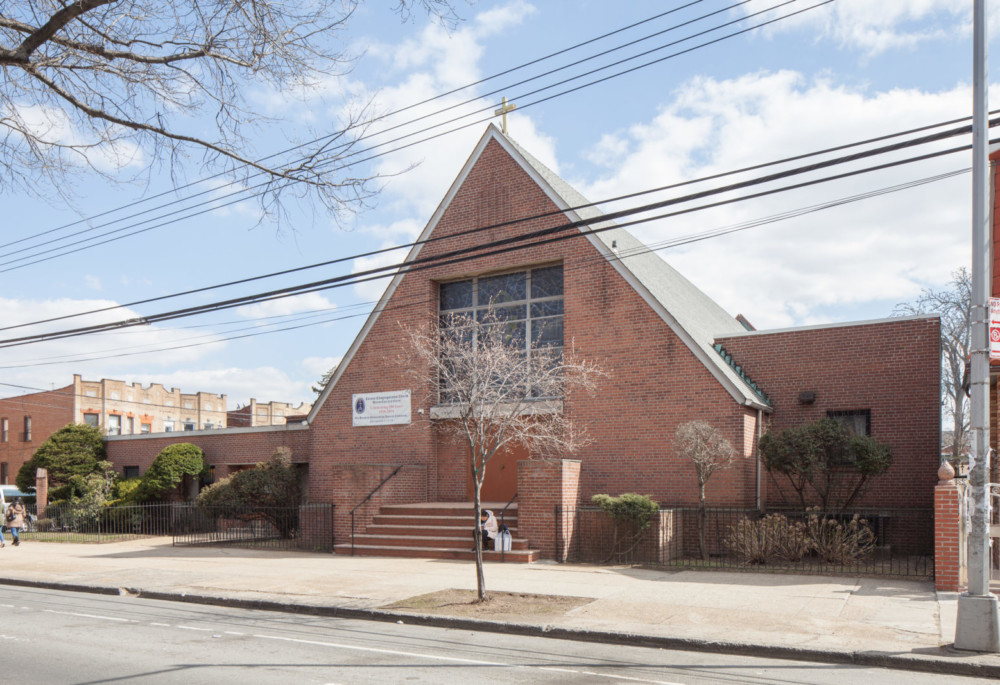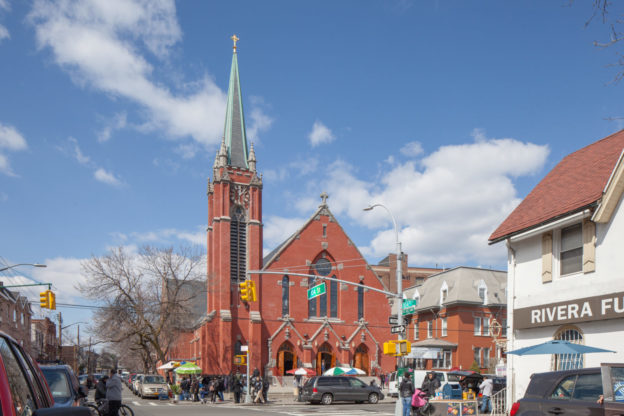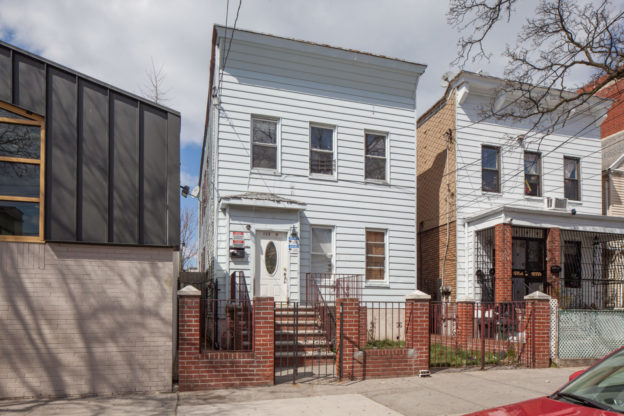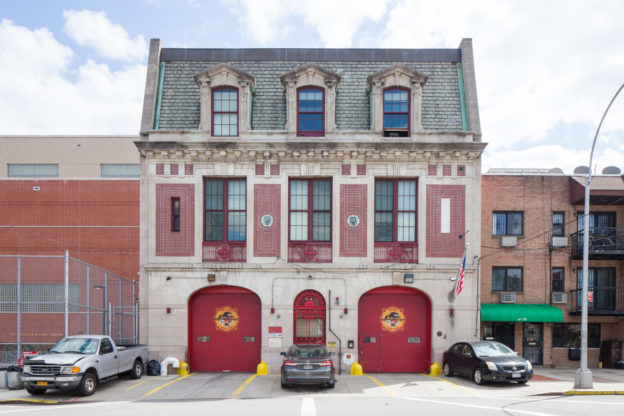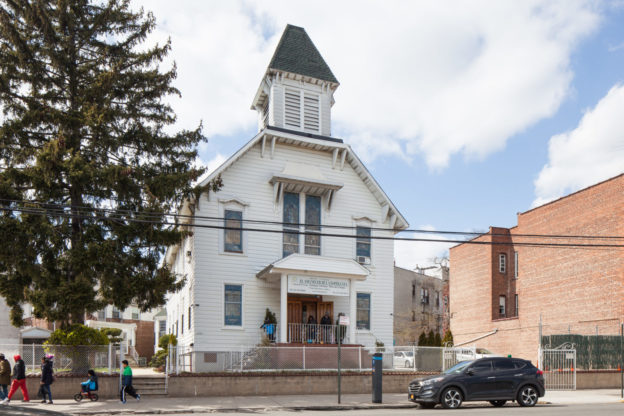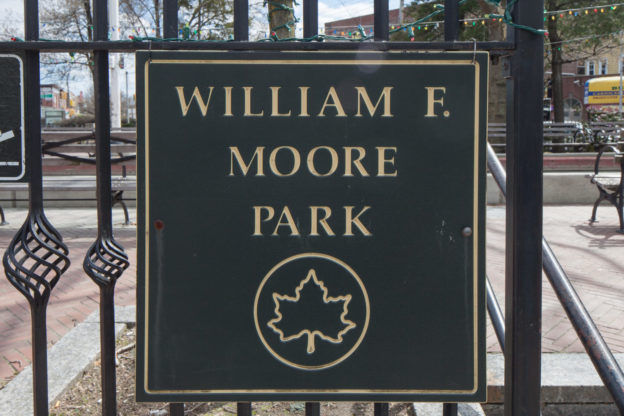102-18 34th Avenue
1952-55
One of the oldest and most storied African- American churches in this section of Queens, this congregation was founded in 1915 by 11 prominent families. Under the guidance of Rev. George W. Hinton (in whose honor the city park adjacent to the Dorie Miller Cooperative Houses is named), pastor from 1916 to 1958, the congregation established itself as a voice for equal rights. In 1929 W. E. B. Du Bois spoke at the church, and in 1939 its members organized lodging for families visiting the World’s Fair who were denied accommodation in segregated hotels. In the 1950s and ‘60s the church developed ties to the NAACP and played a local leadership role during the Civil Rights movement under the leadership of its second pastor, Rev. Robert D. Sherard. During the 1960s, ‘70s and ‘80s, a period of rapid change and destabilization in the neighborhood, members of the congregation battled poverty, racism and social disinvestment, and worked closely with the Corona Branch of the Black Panther Party’s Free Breakfast Program. Today the Church continues its long tradition of social and political activism. Louis Armstrong’s funeral was held here in 1971.
105-19 37th Avenue, 1921-22
34-55 107th Street, Robert W. Johnson, 1910
Located only a block apart are the residences of two jazz legends: great friends and nominal musical rivals John Birks “Dizzy” Gillespie and Louis Armstrong. In the 1940s Gillespie (born in 1917 in South Carolina), made a name for himself as a trumpeter and bandleader in the New York City jazz scene, and is regarded today as one of the fathers of bebop. Gillespie owned and lived in this three-family Colonial Revival style building from 1952-66. Cornetist Louis Armstrong (born in 1901 in New Orleans) lived in this Renaissance Revival style rowhouse with his wife Lucille from 1943 until his death in 1971. Over four decades the Armstrongs left their mark on the house, which remains virtually the same as they left it—from the flamboyant 1970s decor, to the musical memorabilia, to the outdoor bar they installed in the garden for entertaining. After Lucille passed away in 1983, the house was donated by the Louis Armstrong Educational Foundation to the NYC Department of Cultural Affairs. In 2003 the house opened to the public as a museum, still owned by the city but managed by Queens College. The house next door at 34- 52 107th Street serves as the museum’s administrative building. It was bequeathed to the museum by Selma Heraldo, a good friend to the Armstrongs, after her death in 2011. Honoring Heraldo’s gift, the NYC Department of Design and Construction is restoring the house and renovating the interior to better serve the museum. The Louis Armstrong House is an Individual Landmark and listed on the State and National Register of Historic Places.
104-11 37th Avenue, 1899-1900
37-57 104th Street, 1902-03
Both congregations were established in the 19th century during the neighborhood’s early
development, and both buildings were constructed around the turn of the 20th century. The Catholic congregation is older, dating to 1870, when it was established as an offshoot of St. Mary’s of Winfield (a German congregation dating to 1854 in the village of Winfield, now part of Maspeth and Woodside). Damaged by fire in 2016, it has been carefully restored. The complex also includes a rectory (1896), school (1911-12) and convent (1916), the latter two both designed by William J. Ryan. The Lutheran congregation was established a bit later, in 1887, also by German immigrants (note the language on the cornerstone to the left). Compared to the Catholic church with its dominant steeple and grand entrance steps, the Lutheran church is more modest, perhaps reminiscent of mid-19th century German architecture.
104-11 39th Avenue
1906
Better known by his pen name, Crockett Johnson, Leisk (1906- 1975) was a beloved cartoonist and illustrator. (The name derives from his childhood love of the outdoors and Davy Crockett.) His most famous creations were Barnaby (1942-52), a daily comic strip that reached national syndication, and Harold and the Purple Crayon (1955), a series of beloved children’s books. Leisk first published his drawings in the Newtown High School student newspaper. After studying at Cooper Union, he held Art Editor positions including at the Communist-leaning New Masses, where he first began signing his drawings as Crockett Johnson. The Leisk family occupied the second story apartment of this house, then known as 2 Ferguson Street, from the early 1910s until around 1925.
103-14 Roosevelt Avenue
R. Thomas Short
1927
One of two historic theater buildings remaining in the neighborhood (the other being the Corona Theater at 37-80 Junction Boulevard), the Plaza originally opened in 1927 as the Loew’s Plaza Theater and was prominently located on Corona Plaza (now renovated as a pedestrian mall), then the terminus of the Flushing IRT Line. With 2,151 seats, it was indisputably a movie palace. Under the strict Hollywood Studio System, however, it was relegated to third-run status following the opening of the Valencia in Jamaica (1928-29) and the Triboro in Astoria (1931). After a federal antitrust case broke up the system, Loew’s sold the theater in 1952 to Century Theaters. It was later divided into two theaters and operated as the independent Teatro Plaza until 2005. Just south of the theater is Linden Park, also known as Park of the Americas, which once contained Linden Lake, a glacial kettle pond. Before it was drained in 1947, residents enjoyed swimming and lake side concerts in the summer and ice-skating in the winter.
43-18 97th Place
Skidmore, Owings & Merrill
2013-15
This school sits on the grounds of the former Tiffany Studios’ Stourbridge Glass Company. Louis Comfort Tiffany established the company in 1893, importing a foreman and workers from the English town of Stourbridge, a center of glassmaking since the 16th century. Among the glass manufactured at the site was the famed Favrile Glass, an iridescent glass with ingrained coloring developed and patented by Tiffany. The school’s lobby displays a mosaic made from Tiffany glass shards found at the site during construction.
97-28 43rd Avenue
Satterlee & Boyd
1912-14
After Queens County was absorbed into Greater New York in 1898, there was a wave of public building projects as the municipal government consolidated and modernized its services. At the time, Corona had two volunteer fire companies: Louona Engine Company 8 and Pioneer Fire Hook & Ladder 6. The old firehouse of the latter, a wood-framed building from the 1890s, still stands at 41-19 National Street. The city established permanent, professional fire service with the construction of a “modern” firehouse in 1912-14. Like many civic buildings of the period, it was designed in the formal Neoclassical style typical of the City Beautiful movement. Built in the early age of the automobile, it features two apparatus bays purpose-built for fire trucks. It originally contained a dormitory and a second-story terrace for recreation.The firehouse is an Individual Landmark.
102-45 47th Avenue, c. 1871
41-22 to 41-36 National Street, 1869-70
These buildings are amongst the oldest in the neighborhood, survivors of its transit-fueled development in the mid-19th century. The Sanford House’s vernacular Italianate design was typical of the period and is likely similar to many of the area’s vanished old houses. The Union Evangelical Church is Corona’s oldest surviving building, and according to one history of Queens, “originated in a Sunday-school, established in 1869 by Mrs. (Mary) Page. Collecting a few truant children on her porch, she succeeded in interesting them in Bible stories.” Others soon became interested in forming a church, including Charles P. Leverich, who offered his house for services and eventually donated the land and money to construct this building. Leverich’s son Charles was also a supporter and donated a Sunday school building in 1889. As the neighborhood developed and the congregation grew, it established a satellite church in North Corona at 102-19 32nd Avenue. Originally known as the North Branch of the Union Evangelical Church, it was dedicated in 1915 and was later renamed the Leverich Memorial Church in honor of the younger Leverich. Sanford House is an Individual Landmark.
108th Street and Corona Avenue
1922-29
This small triangle of land was acquired by the city in 1924, and was originally known as Corona Heights Triangle. It was renamed in 1929 for Moore, a Marine who died in World War I at the Battle of Belleau Wood—reportedly the war’s first casualty from the neighborhood. The rededication also included the installation of a “Victory Memorial Fountain” by sculptor James S. J. Novelli memorializing 49 local residents who also lost their lives (the fountain has since been removed but the bronze tablet remains). Additional memorials have been added, including a tablet and tree at the park’s southern tip honoring politician and community leader Joseph Lisa, Sr. (1898-1977). The park, at the heart of the neighborhood’s Italian-American community, is affectionately known as “Spaghetti Park” after author Dyann DeSalvo penned the 2002 children’s book by the same name. Its two bocce courts are regularly packed with players and spectators, many enjoying treats from the nearby Lemon Ice King of Corona (established 1944).
109-18 54th Avenue
Crescent L. Varrone
1911
This modest, wood-framed building is considered the oldest surviving synagogue in Queens. Its congregation was formed in 1906 or ‘07 and formally incorporated in 1911 as the Home Street Synagogue (its original name). Many early members were recent immigrant Ashkenazi from Eastern Europe moving from the overpopulated Lower East Side. One of these was the young Josephine Esther Mentzer, a Corona resident who became the cosmetics entrepreneur Estée Lauder. Architecturally the building is reminiscent of small synagogues of the Lower East Side, which had to conform to narrow lot sizes meant for tenements. Its façade, with Gothic and Moorish elements, was restored in 2011-12. The complex eventually included a mikveh (ritual bath), yeshiva (Talmudic school) and cemetery. The yeshiva, located a block away at 108-44 53rd Avenue, later became famous as the brief home of pop star Madonna. From 1979-80 she lived in this loft/music studio, playing drums and keyboards in the band The Breakfast Club.Congregation Tifereth Israel is an Individual Landmark and listed on the State and National Register of Historic Places.
